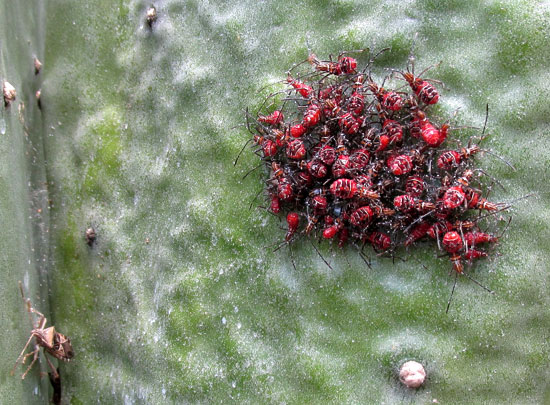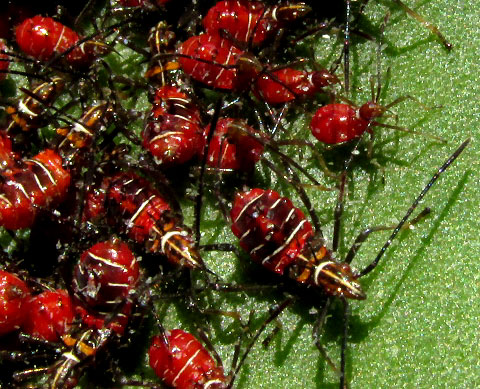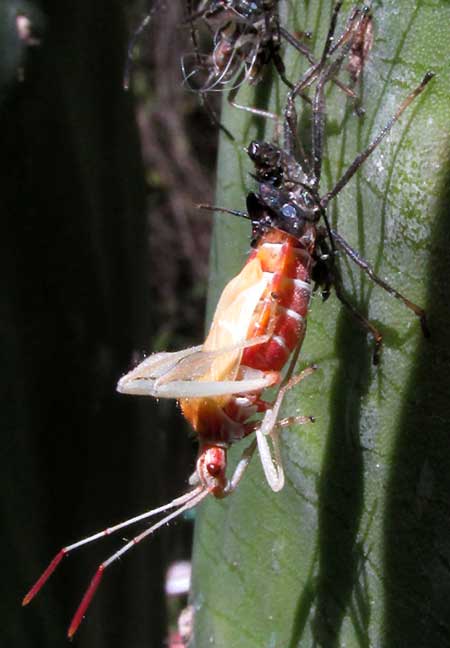Excerpts from Jim Conrad's
Naturalist Newsletter
the January 10, 2016 Newsletter issued from Hacienda Chichen Resort beside Chichén Itzá Ruins,
central Yucatán, MÉXICO
CACTUS BUG NYMPHS
The Nopal cactus in front of the hut bears reddish splotches like these:

That photo, which I'm thinking shows what usually are called Cactus Bugs, LEPTOGLOSSUS LINEOSUS, shows three things worth noting.
First, down in the lower, left corner an adult Cactus Bug seems to be hovering in the vicinity of the brood, though normally we don't think of bugs as watching over their offspring. The next day the adult still was nearby. The third day I couldn't find the adult. On the fourth day the adult had returned but was about a foot away on a different part of the cactus.
Second, the face of this cactus pad is strangely wrinkled, though other pads in the area aren't. Does this reflect internal damage to the pad resulting from the Cactus Bugs' presence?
Finally, there's the offspring themselves, which are "nymphs." Nymphs are the young of insects who undergo simple or incomplete metamorphosis. In complete metamorphosis you have egg > larva > pupa > adult. In simple, you get egg > nymph > adult. Nymphs are basically smaller versions of adults, but with wings and sexual parts only partly or not at all developed. Below, a closer look at some nymphs is provided:

Notice how closely individuals in the cluster position themselves to others, some bugs even climbing atop others. Also, individuals on the cluster's perimeter mostly face outward. Probably they cluster in order to provide a more vivid splotch of red on the green cactus pad, the idea being that often dangerous animals announce themselves with bright colors and patterns, so predators are warned to stay away. However, I find nothing dangerous about these bugs. Lots of species bluff -- like milksnakes which bear red and black bands like venomous coral snakes, though they're harmless.
In the above picture, the variation in size and pattern is striking, It looks as if individuals of different ages live in the group.
I'm documenting these details because earlier we saw that this species is poorly known. Someday someone will be happy to have this information as a starting point for their own studies.
the February 7, 2016 Newsletter issued from Hacienda Chichen Resort beside Chichén Itzá Ruins,
central Yucatán, MÉXICO
METAMORPHOSING CACTUS BUGS
This week most of the nymphs introduced above metamorphosed into adults. Below, you can
see a whitish one with pink highlights almost finished emerging from its blackish husk:

Below, another shot of one whose emergence is less advanced than the one's above reveals how during emergence the head is bent tightly against the abdomen's bottom:

The pictures are shown out of sequence because that last one can be hard to interpret if you don't know what you're looking for. When I first saw an emerging nymph in this stage I thought it was headless, and saw the head only once the picture was on the laptop screen.
Freshly minted adults remain whitish for several hours but by the next day they display the adults' typical colors, shown below:

In that photo recently emerged adults stand next to nymphs that are far from reaching the instar stage at which they also will become adults. We noted earlier that clusters on the hut cactus contained nymphs of various age groups.
Compared to now last week maybe three times the number of nymphs could be found on the cactus, in two or three groups, but something happened to most of them. I noticed this after a particularly chilly night with intermittent sprinkles, but don't know whether there was a connection.
Sometimes when I put my face up close to the cluster one or two larger nymphs raise their rear ends and squirt out drops of fluid. Maybe they do this all the time, or maybe they're doing it just for my benefit.